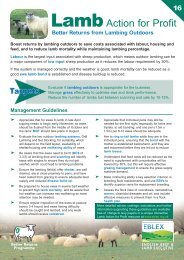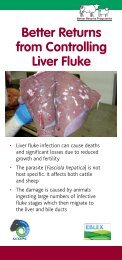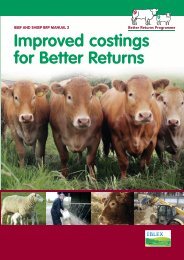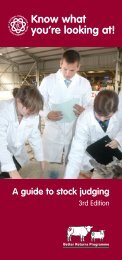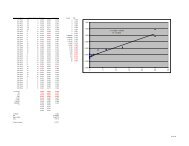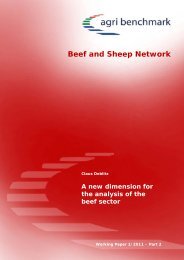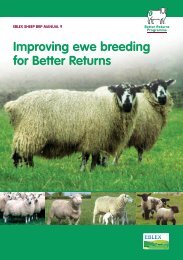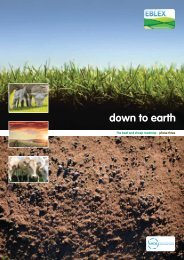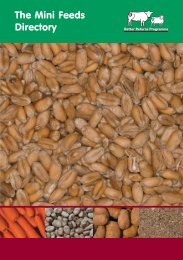Manual 1 â Choosing bulls to breed for better returns - Eblex
Manual 1 â Choosing bulls to breed for better returns - Eblex
Manual 1 â Choosing bulls to breed for better returns - Eblex
Create successful ePaper yourself
Turn your PDF publications into a flip-book with our unique Google optimized e-Paper software.
Growth rateHigh growth rates can enhanceweight of cattle sold, productionefficiency and timing of salesSelecting <strong>bulls</strong> with high 200 and 400Day Growth Rate EBVs ensures heaviercalves at weaning and slaughter.Cattle with high growth rates make more efficient use offeed. There<strong>for</strong>e, feed costs per kilogram of liveweight gainare reduced, as is time <strong>to</strong> slaughter.Cattle with high growth potential are easier <strong>to</strong>400 daysmatch and manage <strong>for</strong> periods of high market <strong>returns</strong>.200 daysBull A:higher rate growth450kg350kgBull B:slower rate growthWhich EBVs are important?200 Day Growth EBV (kg)An indication of <strong>breed</strong>ing potential <strong>for</strong> growth<strong>to</strong> 200 days of age.ExampleBull with EBV of +20kg is estimated <strong>to</strong> producecalves 10kg heavier at 200 days than a bullwith an EBV of 0.400 Day Growth EBV (kg)An indication of <strong>breed</strong>ing potential <strong>for</strong> growth<strong>to</strong> 400 days of age.ExampleBull with EBV of +48kg is estimated <strong>to</strong> producecalves 24kg heavier at 400 days than a bullwith an EBV of 0.RememberThe potential <strong>for</strong> high growth rates is only realised under goodmanagement – adequate feed and high herd health status.BewareSelecting <strong>for</strong> high growth rate alone can increase birthweights, leading <strong>to</strong> calving problems (page 8) – and increasecow mature size, which on some systems might reduce herdefficiency (page 12).Do not select on growth rate EBVs alone.6
Maternal per<strong>for</strong>mance – early fertilityIt is common UK practice <strong>to</strong> calve heifersat 2, 2.5 and 3 years old. Calving at ayounger age under appropriatemanagement, will increase the numberof calves raised during a cow’s lifetimewith consequent financial benefits.Heifers must be reproductively active <strong>to</strong> calve at 2 years.The key fac<strong>to</strong>rs influencing puberty are body conditionscore and liveweight, as well as age. To ensure highconception rates, heifers should reach 2/3 of adultweight be<strong>for</strong>e mating.Breed can influence age of puberty, with native <strong>breed</strong>stending <strong>to</strong> reach puberty earlier than continental ones.Within every <strong>breed</strong> there is variation that can beexploited using EBVs.Which EBVs are important?Producers can select <strong>bulls</strong> using the age at first calving EBV. There is also some relationship betweenbull’s scrotal circumference and the age at which his female progeny will reach puberty.Age at First Calving EBVIdentifies female <strong>breed</strong>ing lines that arereproductively active and capable of conceptionat an early age.ExampleA bull with an EBV of -0.10 will produce 5% morefemales likely <strong>to</strong> have a first calf at an early age(if mated) than a bull with an EBV of 0.Scrotal Circumference EBV (cm)Increasing scrotal circumference in malesenhances reproductive per<strong>for</strong>mance in maleand female progeny.ExampleA bull with an EBV of +4 cm will produce sonswith scrotal circumferences 2cm greater thana bull with an EBV of 0 cm and daughters arelikely <strong>to</strong> reach puberty earlier.• Use careful management when calving heifers at 2 years.• Pay particular attention <strong>to</strong>:– pre-mating and pre-calving nutrition– selection of easy calving <strong>bulls</strong>.9
Maternal per<strong>for</strong>mance – milk productionOptimising a cow’s milk production gives new born calves a good startand provides adequate nutrition up <strong>to</strong> weaning.Assessing <strong>breed</strong>ing potential<strong>for</strong> milk productionProducers <strong>breed</strong>ing replacements can select beefsires <strong>to</strong> improve the herd’s milking ability using the200 Day Milk EBV.Pedigree producers can also score udder and teatcon<strong>for</strong>mation, with EBVs which will become availablein the future (below).sonsdaughtersInfluence ofgrowth genesInfluence ofgrowth genesInfluence ofmilk genes1 2 3Udder score 1 – A tight udder, with the base above the hockUdder score 2 – Normal udder, with the base level with the hockUdder score 3 – Udder hanging below the hocks of the cowWhich EBVs are important?Producers can enhance the milking ability of cows retained within the herd by selecting <strong>bulls</strong> withsuperior 200 Day Milk EBVs.200 Day Milk EBV (kg)Identifies female <strong>breed</strong>ing lines that will producemore milk and so wean heavier calves.ExampleA bull with an EBV of +8kg will produce femaleprogeny whose calves are 4kg heavier at200 days than a bull with an EBV of 0.Teat Score EBV & Udder Score EBV – (Signet)Could enable <strong>breed</strong>ers <strong>to</strong> <strong>breed</strong> beef cattlewith superior udder con<strong>for</strong>mation.ExampleAvailable in the future.• Purchase sires with superior 200 Day Milk EBVs <strong>to</strong> <strong>breed</strong> femalereplacements with increased milk production.• Do not select on this trait when <strong>breed</strong>ing replacementsout of dairy cows.11
Maternal per<strong>for</strong>mance – cow efficiencySelecting <strong>to</strong> improve growth rate will lead <strong>to</strong> increased mature cow size in most herds. Where feed is plentiful andfeed costs low this may not be a bad thing. However, where feed supply is limited, using a smaller cow requiringlower feed requirements can be advantageous. Smaller-framed animals are more likely <strong>to</strong> retain a higher bodycondition score under harsh conditions. This greatly enhances overall fertility.Breeding smaller cowsAdvantages✓ Lower feed costs✓ Higher s<strong>to</strong>cking rates✓ More fertile underharsh conditions✓ Easier <strong>to</strong> outwinter/cheaper <strong>to</strong> houseDisadvantages✗✗✗Lower cull cow valueLighter weight calvesPotential <strong>for</strong> morecalving problems✓ Potential <strong>to</strong> reachpuberty earlierProducers can select <strong>breed</strong>ing s<strong>to</strong>ck with superior EBVs <strong>for</strong> early (200 day) growth rate, but low mature size.The growth curve of these animals is unconventional and they are referred <strong>to</strong> as “curve benders”.Producers can also enhance herd efficiency by extending cow longevity. This can be achieved throughwithin <strong>breed</strong> selection using EBVs or cross<strong>breed</strong>ing <strong>to</strong> exploit hybrid vigour.Which EBVs are important?A Mature Size EBV will enable producers <strong>to</strong> modify mature cow size. Longevity EBVs are available<strong>to</strong> extend cows’ reproductive life within the herd.Mature Size EBVEstimates size at maturity.ExampleA bull with Mature size EBV of -50kg willproduce female replacements 25kg lighterat maturity than a bull with an EBV of 0.Longevity – (Signet)Estimates how long cows will bereproductively active in the herd.ExampleA bull with a Longevity EBV of +1.0 year willproduce female replacements that live 0.5years longer in the herd than females siredby a bull with an EBV of 0.• In herds that <strong>breed</strong> female replacements, increased calf growth rateleads <strong>to</strong> increased cow mature size. This can be controlled usingMature Size EBVs.• Optimum cow size <strong>for</strong> the herd depends on available resources,particularly feed.12
Breeding indexesEBVs enable s<strong>to</strong>ck <strong>to</strong> be selected <strong>for</strong> specific traits. However, theycan be combined in<strong>to</strong> indexes <strong>to</strong> meet specific <strong>breed</strong>ing objectives.Each trait is weighted according <strong>to</strong> its relative economic value <strong>to</strong> providea single figure on which selection decisions can be based.IndexesCalving ValueAim: Reduce cost of difficult calvingsEBVs• Gestation Length• Calving Ease• Birth Weight• 200 Day GrowthBeef Value/Terminal Sire IndexAim: Increase carcase values• 400 Day Growth• Muscle Score• Muscle Depth / Area• Fat Depth• Age at First CalvingMaternal ValueAim: Identify superior genetics <strong>to</strong>produce female replacementsMaintenance ValueAim: Reduce cow maintenance costs• Maternal Calving Ease• Scrotal Circumference• Calving Interval• 200 Day Milk• Longevity• Mature SizeMaternal Production ValueAim: Identify superior genetics <strong>to</strong> producequality female replacements withbeef carcase characteristics• Calving Value• Beef Value• Maternal Value• Maintenance ValueThose EBVs shown in blue are only available <strong>for</strong> Signet recorded herds. “Maternal Production Value”,designed <strong>to</strong> assist producers <strong>breed</strong>ing a self replacing suckler herd.Breedplan has developed beef indices <strong>for</strong> individual <strong>breed</strong>s, with weightings cus<strong>to</strong>mised <strong>to</strong> <strong>breed</strong>characteristics. A maternal index is under development <strong>for</strong> some <strong>breed</strong>s and a suckler replacementindex is available <strong>for</strong> others. Breed societies can provide further in<strong>for</strong>mation.• Use indexes as an overall guide.• Consider EBVs <strong>for</strong> particular <strong>breed</strong>ing objectives.13
Interpreting EBVs when buyinga recorded bullEBV data <strong>for</strong> two Limousin BullsBuyers can use EBVs <strong>to</strong> assess a bull’s strengths andweaknesses. Only then can they decide whether it hasthe right <strong>breed</strong>ing attributes <strong>for</strong> their herd. Compare andcontrast the EBVs <strong>for</strong> these two Limousin <strong>bulls</strong>.Bull A: Winterhill RobertSire: Winterhill BobDam: Bradwell MaryAnalysis date Calving 200 Day 200 Day 400 Day Muscle Fat Depth BeefValue Milk (kg) Growth (kg) Growth (kg) Depth(mm) (mm) ValueE B V LM1C +4 +28 +42 +4.1 -0.1 LM27Accuracy % 57 42 72 69 69 62 63100 200 300 400 500 Scannedday wt. day wt. day wt. day wt. day wt.118 253 378 556 710 YESBull B: Huntingdon FredSire: Oakham IanDam: Oldbrook ClareAnalysis date Calving 200 Day 200 Day 400 Day Muscle Fat Depth BeefValue Milk (kg) Growth (kg) Growth (kg) Depth(mm) (mm) ValueE B V LM6C -5 +30 +52 +2.0 +0.3 LM25Accuracy % 59 43 73 68 66 60 64100 200 300 400 500 Scannedday wt. day wt. day wt. day wt. day wt.126 256 385 568 744 YESAccuracyBelow 50% 50–74%preliminarymedium75–90% Over 90%medium/highhighAt sales EBVs are often presented in a graphic <strong>for</strong>m.The higher the level of accuracy,the less likelihood of radical change<strong>to</strong> an EBV.14
Breed benchmark exampleThe Breed benchmark indicates the distribution of EBVs across the <strong>breed</strong>. The benchmark can beused <strong>to</strong> identify an animal’s ranking within the <strong>breed</strong>.Trait Bot<strong>to</strong>m Breed Top1% 10% 25% average 25% 10% 1%Calving Value LM-4C LM-1C LM0C LM1C LM2C LM3C LM5C200 Day Milk (kg) -7 -3 -2 0 1 3 6200 Day Growth (kg) -8 0 5 12 18 24 37400 Day Growth (kg) -13 0 10 21 31 41 63Muscle Depth (mm) -1.4 -0.1 0.5 1.3 2.1 3.0 4.7Fat Depth (mm) 0.4 0.1 0 -0.1 -0.2 -0.3 -0.5Beef Value LM0 LM6 LM11 LM16 LM20 LM25 LM34By comparing each bull’s EBVs against the <strong>breed</strong>’s EBV benchmark:• Each bull has been fully weight recorded and scanned with satisfac<strong>to</strong>ry accuracy figures (<strong>for</strong> a young animal).• Both <strong>bulls</strong> have above average EBVs <strong>for</strong> growth and carcase traits and would make suitable <strong>bulls</strong><strong>for</strong> use as terminal sires, but in several important ways their characteristics differ:Bull A: Winterhill Robert• has high Muscle Depth EBVs• has a 200 Day Milk EBV in the Top 10%of the <strong>breed</strong>Bull B: Huntingdon Fred• has the highest EBVs <strong>for</strong> Growth Rate• has a Calving Value in the Top 1% of the <strong>breed</strong>Bull A would be ideal <strong>for</strong> beef production where cattle are sold <strong>for</strong> slaughter and carcase qualitytakes a high priority. The high 200 Day Milk EBV would also make it a suitable sire <strong>for</strong> herds where femalereplacements are being retained <strong>for</strong> <strong>breed</strong>ing.Bull B would be suitable <strong>for</strong> mating <strong>to</strong> heifers because of its high Calving Value.It could also be used in herds where the <strong>to</strong>p priority is <strong>to</strong> improve growth rate.• Take your time• Consider your <strong>breed</strong>ing objectives• Select <strong>bulls</strong> with the right EBVs <strong>for</strong> your needs15
Selecting a bull <strong>for</strong>physical soundnessWhile EBVs will help bull buyers select <strong>breed</strong>ings<strong>to</strong>ck <strong>for</strong> a range of economically important traits,a subjective assessment is still required <strong>to</strong> assessfertility, temperament and structural soundness.Fertility is one of the most important traits, becauseinfertile <strong>bulls</strong> are a major source of economic loss.Check scrotal <strong>to</strong>ne and size, as testicle size has adirect influence on daily sperm production andhence mating load.For a bull <strong>to</strong> actively seek out cows <strong>for</strong> mating andmount them, it needs <strong>to</strong> be physically fit, possessgood locomotion and be free from pain or discom<strong>for</strong>t.More <strong>bulls</strong> are culled <strong>for</strong> problems with their hindlimbs than <strong>for</strong> any other structural condition,so check their feet and legs carefully.Bull health and fertility- be<strong>for</strong>e and after purchaseIt is often said, quite correctly, that the bull is half the herd. This suggeststhat he should be regarded as being as important as all the other s<strong>to</strong>ckput <strong>to</strong>gether. Yet in practice he is often lucky if he receives half the careand attention of the other s<strong>to</strong>ck.This leaflet offers advice on how <strong>to</strong> care <strong>for</strong> the healthand fertility of what is probably the most expensiveasset in your herd - the s<strong>to</strong>ck bull.For more guidance on bull careask <strong>for</strong> this leaflet free from EBLEX BeefBetter Returns ProgrammeAnd finally… look after your new bullLooking after a new bullHaving purchased a new bull it is important <strong>to</strong>get him settled in his new environment as quicklyas possible.Delivery• Ensure the bull is loaded quietly, placed on anon-slip surface within the cattle float and tiedcorrectly, <strong>to</strong> prevent problems in transit.Health status• Avoid unloading a new bull straight in<strong>to</strong> theherd. Rest him in a quiet part of the yard,where he can be isolated and moni<strong>to</strong>red <strong>for</strong>signs of ill health.• As well as checking the sellers’ herd healthstatus prior <strong>to</strong> purchase, find out when thebull’s next set of vaccinations are due.Starting work• Let him see his new surroundings andother s<strong>to</strong>ck.Avoid keeping him in a confined space andensure the surface on which he is walking andwill be expected <strong>to</strong> work is not uneven,slippery or very soft.• Find out what your new bull has been fed prior<strong>to</strong> sale and use this knowledge <strong>to</strong> gently adjusthim on<strong>to</strong> his new diet, starting with somethingsimple like hay.The money spent on your new bullis a major investment in the herd.It is time well spent getting himsettled in and ensuring he is fitand healthy.16
ContactsName and addressContact no. email/webEBLEXwww.eblex.org.ukBetter Returns ProgrammeNetta de la Cour, Project Manager Tel: 0870 241 8829 nettad@eblex.org.ukHeather Stewart, Project Administra<strong>to</strong>r Tel: 0870 241 8829 brp@eblex.org.ukGraphic House, Ferrars Road, Huntingdon PE29 3EERegional ManagersWestern Region: Clive Brown Tel: 0870 241 8528 cliveb@eblex.org.ukRosedale House, Askham Bryan College, York YO23 3FRNorth East Region: Steve Powdrill Tel: 0870 241 8528 stevep@eblex.org.ukRosedale House, Askham Bryan College, York YO23 3FREast Region: Michael Richardson Tel: 0870 242 1394 michaelr@eblex.org.ukGraphic House, Ferrars Road, Huntingdon PE29 3EESouth East Region: Nick Allen Tel: 0870 241 9012 nicka@eblex.org.ukGraphic House, Ferrars Road, Huntingdon PE29 3EESouth West Region: Peter Reynolds Tel: 0870 608 6610 peterr@eblex.org.ukOffice Suite A, Hamil<strong>to</strong>n Road, Taun<strong>to</strong>n, Somerset TA1 2YHSouth West Region: Phil Hadley Tel: 0870 608 6610 philh@eblex.org.ukOffice Suite A, Hamil<strong>to</strong>n Road, Taun<strong>to</strong>n, Somerset TA1 2YHLiz Ford, Regional Project ManagerRosedale House, Askham Bryan College, York YO23 3FR Tel: 0870 241 8528 lizf@eblex.org.ukMLC’s Signet Breeding ServicesPO Box 603 , Winterhill, Mil<strong>to</strong>n Keynes MK6 1EL Tel: 01908 844 210 www.signetfbc.co.uksignet@mlc.org.ukPedigree Cattle Services (Breedplan)Pedigree House, 6 King's Place, Perth, Scotland, PH2 8AD Tel. 01738 622478 www.<strong>breed</strong>plan.co.ukbarbara@<strong>breed</strong>plan.co.uk17
For more in<strong>for</strong>mation contact:Beef Better Returns ProgrammeEBLEXGraphic HouseFerrars RoadHuntingdonPE29 3EEFunded bywww.defra.gov.ukTel: 0870 241 8829Fax: 0871 433 6205Email: brp@eblex.org.ukwww.eblex.org.uk© EBLEX 2007The tables and contents of thispublication may not be reproducedwithout the express permissionof EBLEX.R262457 July 07





